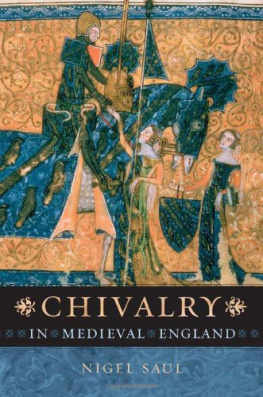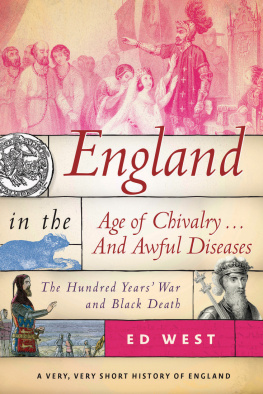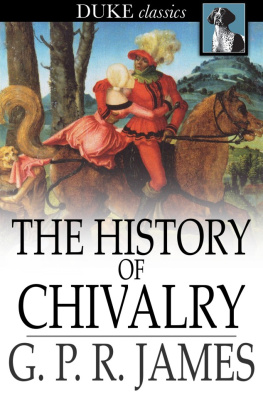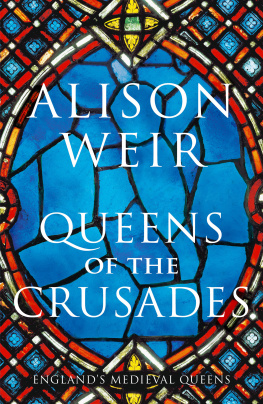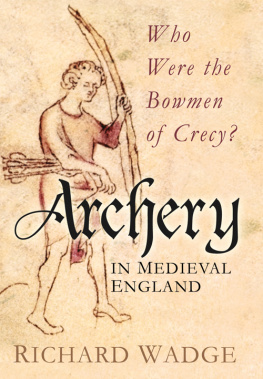CHIVALRY
in Medieval England
NIGEL SAUL
Harvard University Press
Cambridge, Massachusetts
2011
Copyright 2011 by Nigel Saul
Nigel Saul has asserted hisright under the Copyright, Designs
and Patents Act 1988 to beidentified as the author of this work
All rights reserved
Printed in the United States ofAmerica
First published in GreatBritain in 2011 by The Bodley Head as
For Honour and Fame: Chivalryin England, 10661500
First Harvard University Pressedition, 2011
Library of CongressCataloging-in-Publication Data
Saul, Nigel.
Chivalry in medieval England /Nigel Saul.
1st Harvard University Pressed.
p. cm.
Includes bibliographicalreferences and index.
ISBN 978-0-674-06368-6 (cloth :alk. paper)
1. ChivalryGreatBritainHistory. 2. Knights and knighthood
Great BritainHistory. 3. GreatBritainHistoryMedieval
period, 10661485. 4.EnglandCivilization10661485. I. Title.
CR4529.G7S28 2011
394'.941dc23 2011025157
For my wife
Preface
To write about chivalry in medievalEngland is to embark on a voyage through a world at once glamorous and violent,alluring and yet elusive. For many, chivalry evokes images of knights inshining armour, menfolk competing for the attention of a fair lady, pennons andstreamers fluttering from castle battlements. Much of this picture is a productof the nineteenth-century romanticisation of the Middle Ages the kind ofre-creation that gave us Waterhouses Lady of Shalott and Viollet-le-Ducsrebuilding of Carcassonne. Its roots lay in an idealised view of the medievalpast which grew up in reaction to the horrors of the grim industrialisation ofthe time. The real medieval world was altogether less lyrical and moredown-to-earth than the fanciful re-creation. Nonetheless, we know enough aboutthe cultural achievements of the Middle Ages to be aware that the image of thefully accoutred mounted knight was one which attracted and captivatedcontemporaries. The tales of King Arthur and his Knights of the Round Tableinspired a whole genre of vernacular romance literature. The prowess of theknights of the Hundred Years War was celebrated in Froissarts Chronicle , one of the most compellingnarrative accounts of the medieval period. From the early twelfth century theknightly class dominated the secular landscape of western Europe, spawning anaristocratic culture which was shaped in their heroic image and reflected theirmartial values. It is that richly layered chivalric world, which has done somuch to influence our own view of the Middle Ages, which is the subject of thisbook.
Over a quarter of a century ago anotherbook was published which was to be the point of departure for all modernstudies of chivalry. This was Maurice Keens Chivalry , an ambitious, pioneering work whichrescued chivalry from the hands of lyrical escapists and placed it firmly inthe forefront of medieval studies. The aim of the present volume is to build onthe foundations which Keen laid and to do so by engaging with his legacy morespecifically in the context of medieval England. The book will accordinglyconcern itself with how chivalry shaped both the practice of kingship inEngland and the expectations which people had of their kings, with how itspawned a rich and distinctive aristocratic culture, and how its values infusedaristocratic codes of behaviour and personal piety. It will look, too, at theknights and gentry at home, at their changing role in society and their placein local office-holding and administration. It will look at the architecture ofchivalry, at the castles and fortifications which were the outward face of thearistocratic elite and proclaimed its militant values. It will look ataristocratic women and their relationship with chivalric culture. Finally, it willattempt a consideration of what the legacy of chivalry might be to us today.
Chivalry was the value system andbehavioural code of the secular aristocratic elite of the Middle Ages. Studyingit focuses our attention on the social group which made the biggest and mostforceful impact on the contemporary world. It affords us the opportunity toexplore a world at once colourful and visual, mannered and polite, prickly andviolent. It introduces us to a society whose values were very different fromour own.
Acknowledgements
I would like to record my appreciation toWill Sulkin and Kay Peddle of The Bodley Head for their careful and patientwork on the preparation of this book. I am especially grateful to Will Sulkinfor his meticulous editorial work, which has added greatly to the booksdistinction.
Contents
List of Illustrations
Introduction: Chivalry and History
The Origins of English Chivalry
Chivalry and Empire, 1066 1204
The Making of Chivalric Culture, 1100 1250
Knighthood Transformed, 1204
Kingship and War, 1272 1327
Edward III and Chivalric Kingship, 1327
War, Fame and Fortune
The Face of Chivalric War
Chivalry and Nobility
Chivalry and Violence
Chivalry and Christian Society
Chivalry and Crusading
Chivalry and Fortification
Chivalry and Women
Memory and Fame
Chivalric Literature, 1250 1485
The Wars of the Roses and Yorkist Chivalry
The Decline of Chivalry
Conclusion
Listof Illustrations
Colour-washed drawing of a kneeling knight, added c . 1250 to a Westminster psalter of the earlythirteenth century ( British Library/ Bridgeman Art Library)
Sir Geoffrey Luttrell being armed by his wife anddaughter-in-law, from the Luttrell Psalter, c . 1335 ( BritishLibrary/Bridgeman Art Library )
Odo, Bishop of Bayeux, at the Battle of Hastings, from theBayeux Tapestry ( BridgemanArt Library )
Tomb effigy attributed to William Marshal, Earl ofPembroke, in the Temple church, London ( Chris Christodoulou )
The chancel, Stoke dAbernon church, Surrey, third quarterof the thirteenth century ( author )
The Round Table in the hall of Winchester Castle, latethirteenth century (John Crook )
Rubbing of the brass of Sir Hugh Hastings (d. 1347 ), Elsing church, Norfolk ( Jon Bayliss )
Tile showing a knight with a couched lance, Ottery St MaryChurch, Devon ( author )
Crossslab grave cover, Salford Church, Bedfordshire, earlyfourteenth century ( author )
The English saints window, Heydour Church, Lincolnshire, c . 1360 ( author )
Tattershall Castle, Lincolnshire, the keep, c . 1430 . To one side of the castle, and out of view, is the church, whichLord Cromwell rebuilt at the same time ( the late Nicholas More )
Dover Castle, Kent, the keep, c . 1170 (John Goodall )
Cooling Castle, Kent, entrance gate to the inner courtyard, c . 1380 ( author )
Warkworth Castle, Northumberland, the keep, late fourteenthcentury (John Goodall )
Drawing of the brass of Joan, Lady Cobham (d. 1434 ), Cobham Church, Kent ( Society of Antiquaries )
Tomb of Reginald, Lord Cobham KG (d. 1361 ), Lingfield church, Surrey ( author )
Drawing of the brass of Robert Wyvill, Bishop of Salisbury(d. 1375), in Salisbury Cathedral ( Edward Kite )
The chantry chapel of Richard Beauchamp, Earl of Warwick(d. 1439), St Marys Church, Warwick ( author )
Drawing of the Battle of Shrewsbury from the BeauchampPageant, c . 1490 ( British Library, Shaun Tyas)
Sir William Chamberlain KG (d. 1462 ), from the east window of East Harlingchurch, Norfolk (Jon Bayliss )
Portrait relief of Sir Thomas Lovell, attributed to PietroTorregiano,
Next page
